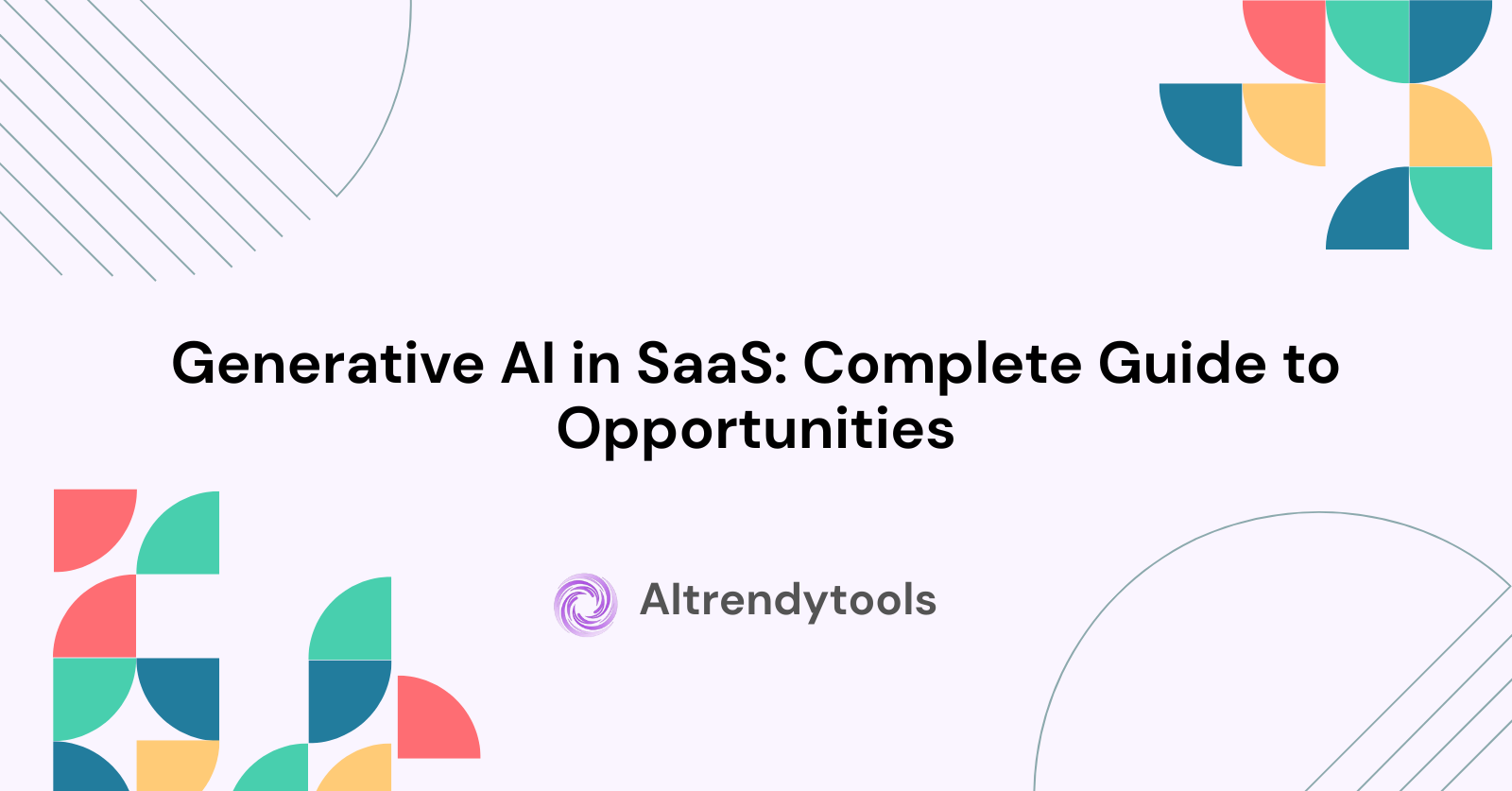🔥 AITrendytools: The Fastest-Growing AI Platform |
Write for usGenerative AI in SaaS: Complete Guide to Opportunities
Discover how generative AI transforms SaaS platforms. Learn key opportunities, implementation challenges, and strategies for AI-powered growth.
Sep 15, 2025
The software-as-a-service industry stands at a pivotal moment where generative AI in SaaS is reshaping how businesses operate and serve customers. Companies worldwide are discovering unprecedented opportunities to enhance their platforms while navigating complex implementation challenges. This transformation affects everything from customer service automation to data analytics and product development.
Modern SaaS platforms are integrating AI-powered solutions at an accelerated pace. The global AI in SaaS market is projected to reach significant milestones in the coming years. Businesses that embrace these technologies early position themselves for competitive advantages in efficiency, customer satisfaction, and market growth.
Understanding both the opportunities and challenges of generative AI implementation becomes crucial for SaaS leaders making strategic decisions. This comprehensive guide explores practical applications, real-world benefits, and actionable strategies for successful AI integration.
Understanding Generative AI in Modern SaaS Platforms
Generative artificial intelligence represents a fundamental shift in how SaaS applications process and create content. Unlike traditional software that follows predetermined rules, AI-powered SaaS solutions can generate original responses, analyze complex patterns, and adapt to user behavior in real-time.
The technology encompasses various applications within SaaS environments. Machine learning algorithms power predictive analytics, natural language processing enhances user interfaces, and automated content generation streamlines workflows. These capabilities transform static software into dynamic, intelligent platforms that evolve with user needs.
SaaS companies leverage generative AI across multiple touchpoints:
- Customer support automation through intelligent chatbots and ticket routing
- Content creation tools for marketing and documentation
- Personalized user experiences based on behavior analysis
- Predictive maintenance and system optimization
- Advanced data visualization and reporting capabilities
The integration process requires careful planning and technical expertise. Successful implementations align AI capabilities with specific business objectives while maintaining system reliability and user trust.
Key Opportunities for AI-Powered SaaS Solutions
Enhanced Customer Experience Through Personalization
Generative AI enables SaaS platforms to deliver highly personalized experiences that adapt to individual user preferences and behaviors. AI algorithms analyze user interaction patterns, feature usage, and historical data to customize interfaces, recommend relevant tools, and predict user needs before they arise.
Personalization extends beyond basic customization. Advanced AI systems can modify workflow suggestions, adjust notification preferences, and even reorganize dashboard layouts based on user productivity patterns. This level of intelligent adaptation significantly improves user engagement and platform stickiness.
The impact on customer satisfaction is measurable. Companies implementing AI-driven personalization report:
- Increased user engagement by 40-60%
- Higher customer retention rates through improved satisfaction
- Reduced churn as users find greater value in personalized experiences
- Enhanced productivity through optimized workflows
Automated Customer Support and Service Optimization
AI-powered customer support represents one of the most immediate opportunities for SaaS improvement. Intelligent chatbots handle routine inquiries, categorize support tickets automatically, and provide instant responses to common questions. This automation reduces response times while allowing human agents to focus on complex issues requiring personal attention.
Advanced natural language processing enables support systems to understand context, sentiment, and urgency levels in customer communications. The technology can escalate critical issues immediately while providing detailed solutions for standard problems.
Implementation benefits include:
- 24/7 availability for customer support without increased staffing costs
- Faster resolution times through automated problem identification
- Consistent service quality across all customer interactions
- Comprehensive knowledge base updates based on common queries
Data Analytics and Business Intelligence Enhancement
Generative AI transforms how SaaS platforms process and present business intelligence. Traditional analytics tools require manual configuration and interpretation. AI-powered systems automatically identify trends, generate insights, and create comprehensive reports that highlight actionable business opportunities.
The technology excels at processing large datasets and identifying patterns that human analysts might miss. Machine learning algorithms continuously improve their accuracy by learning from historical data and user feedback. This evolution ensures that insights become more relevant and valuable over time.
Key advantages include:
- Automated report generation with natural language explanations
- Predictive analytics for forecasting business trends
- Real-time anomaly detection to identify issues early
- Custom visualization creation based on data characteristics
Scalable Content Generation and Management
Content creation becomes significantly more efficient with generative AI integration. SaaS platforms can automatically generate documentation, help articles, marketing copy, and user guides based on product features and user requirements. This capability is particularly valuable for companies managing multiple products or serving diverse market segments.
AI-powered content systems maintain consistency in tone, style, and technical accuracy while producing large volumes of material. The technology can adapt content complexity based on target audience expertise levels and customize messaging for different user personas.
Content generation opportunities include:
- Automated documentation that updates with product changes
- Personalized onboarding materials for different user types
- Dynamic help content based on user context and current tasks
- Marketing copy optimization through A/B testing and performance analysis
Implementation Challenges in SaaS AI Integration
Technical Infrastructure and Architecture Complexity
Integrating generative AI into existing SaaS platforms presents significant technical challenges that require careful planning and substantial infrastructure investments. Legacy systems often lack the computational resources and architectural flexibility needed to support AI workloads effectively.
Modern AI applications demand high-performance computing capabilities, including GPU acceleration for machine learning tasks and scalable storage solutions for training data. Many SaaS platforms must undergo substantial infrastructure upgrades to accommodate these requirements without compromising existing service performance.
Database architecture becomes particularly complex when incorporating AI features. Traditional relational databases may not efficiently handle the unstructured data that AI systems generate and consume. Companies often need to implement hybrid storage solutions combining SQL databases with NoSQL systems and specialized vector databases for AI applications.
The integration process involves multiple technical considerations:
- API design modifications to support AI-generated content and responses
- Real-time processing capabilities for immediate AI responses
- Data pipeline optimization for continuous model training and improvement
- Microservices architecture to isolate AI components from core platform functions
- Performance monitoring to ensure AI features don't impact overall system speed
Data Privacy and Security Concerns
AI implementation in SaaS platforms raises complex privacy and security challenges that require comprehensive solutions. Generative AI systems process vast amounts of user data to deliver personalized experiences, creating potential vulnerabilities and regulatory compliance issues.
Data governance becomes critical when AI systems learn from customer information. Companies must implement strict protocols to ensure that AI training doesn't expose sensitive customer data or violate privacy agreements. This requirement is particularly challenging for SaaS platforms operating across multiple jurisdictions with varying privacy laws.
Security considerations extend beyond traditional cybersecurity measures. AI systems can be vulnerable to adversarial attacks, data poisoning, and model manipulation. SaaS providers must implement specialized security protocols to protect AI components while maintaining the transparency and explainability that customers expect.
Essential security measures include:
- End-to-end encryption for AI data processing and storage
- Differential privacy techniques to protect individual user information
- Regular security audits specific to AI system vulnerabilities
- Access controls limiting AI system permissions and capabilities
- Incident response procedures for AI-related security breaches
Cost Management and ROI Considerations
The financial implications of AI integration extend beyond initial implementation costs to ongoing operational expenses that can significantly impact SaaS profitability. Computing resources for AI workloads are expensive, particularly for real-time applications that require immediate responses.
Training and maintaining AI models requires substantial computational resources. Large language models and complex machine learning algorithms consume significant processing power during both training and inference phases. These costs can quickly escalate as user bases grow and AI features become more sophisticated.
Personnel costs add another layer of complexity. AI implementation requires specialized technical expertise that commands premium salaries. SaaS companies often struggle to find qualified AI engineers, data scientists, and machine learning specialists, leading to increased recruitment costs and extended development timelines.
Financial considerations include:
- Infrastructure scaling costs as AI usage grows
- Model training expenses for continuous improvement
- Specialized talent acquisition and retention costs
- Third-party AI service fees for external APIs and tools
- Compliance and governance overhead for AI system management
Regulatory Compliance and Ethical AI Implementation
Navigating the evolving regulatory landscape around AI technology presents ongoing challenges for SaaS providers. Different regions are implementing varying requirements for AI transparency, explainability, and accountability. Companies must stay current with changing regulations while maintaining competitive AI capabilities.
Ethical AI implementation requires careful consideration of bias detection and mitigation strategies. AI systems can inadvertently perpetuate or amplify existing biases present in training data. SaaS platforms must implement monitoring systems to detect biased outcomes and corrective measures to ensure fair treatment of all users.
Transparency requirements are becoming more stringent as regulators focus on AI decision-making processes. Users increasingly expect to understand how AI systems make recommendations or automated decisions that affect their experience. This transparency must be balanced with protecting proprietary algorithms and maintaining competitive advantages.
Compliance requirements encompass:
- Algorithm auditing for bias detection and mitigation
- Explainable AI implementation to provide decision transparency
- User consent management for AI data processing
- Regular compliance assessments as regulations evolve
- Documentation standards for AI system behavior and limitations
Strategic Approaches to AI Integration Success
Phased Implementation Strategy for SaaS AI Adoption
Successful AI integration in SaaS platforms requires a methodical approach that minimizes risk while maximizing learning opportunities. A phased implementation strategy allows companies to test AI capabilities in controlled environments before scaling across entire platforms.
The initial phase should focus on low-risk, high-impact applications where AI can demonstrate clear value without affecting critical system operations. Customer support chatbots, content recommendations, and basic analytics automation provide excellent starting points for AI experimentation.
Each subsequent phase builds upon previous successes while addressing more complex use cases. This progressive approach allows teams to develop AI expertise gradually and refine implementation processes based on real-world experience. User feedback during early phases informs feature development and helps identify the most valuable AI applications for specific customer segments.
Phase 1 typically includes:
- Pilot AI features with limited user groups
- Basic automation for routine tasks and processes
- Simple personalization based on user preferences
- Performance monitoring to establish baseline metrics
Phase 2 expands capabilities:
- Advanced analytics with predictive capabilities
- Enhanced personalization using behavioral data
- Automated content generation for specific use cases
- Integration optimization based on Phase 1 learnings
Phase 3 focuses on sophistication:
- Complex AI workflows spanning multiple platform areas
- Advanced machine learning models for specialized functions
- Real-time decision making based on comprehensive data analysis
- Full-scale deployment across entire user base
Building AI-Ready Infrastructure and Team Capabilities
Creating a foundation for successful AI implementation requires both technical infrastructure upgrades and human capital development. SaaS platforms must invest in scalable computing resources, data management systems, and monitoring tools specifically designed for AI workloads.
Infrastructure planning should account for both current AI requirements and future expansion needs. Cloud-based solutions offer flexibility and scalability advantages, allowing companies to adjust resources based on actual usage patterns rather than peak capacity estimates. Hybrid cloud architectures can balance performance requirements with cost optimization goals.
Team development is equally important as technical infrastructure. AI implementation requires diverse skill sets including machine learning engineering, data science, AI ethics, and specialized quality assurance. Companies should invest in training existing team members while strategically hiring specialists for critical roles.
Essential infrastructure components:
- Scalable computing resources with GPU acceleration capabilities
- Data storage solutions optimized for AI workloads
- MLOps platforms for model deployment and management
- Monitoring and observability tools for AI system performance
- Security frameworks designed for AI applications
Team capability requirements:
- Machine learning engineers for model development and deployment
- Data scientists for algorithm design and optimization
- AI ethics specialists to ensure responsible implementation
- DevOps engineers experienced with AI deployment pipelines
- Product managers who understand AI capabilities and limitations
Measuring Success and Optimizing AI Performance
Establishing comprehensive metrics for AI performance evaluation ensures that implementations deliver expected business value. Traditional SaaS metrics may not fully capture the impact of AI features, requiring new measurement frameworks that account for AI-specific benefits and challenges.
User engagement metrics become more sophisticated when AI personalization is involved. Simple page views or feature usage statistics don't adequately reflect the quality of AI-driven experiences. Companies must track metrics like recommendation acceptance rates, task completion efficiency, and user satisfaction with AI-generated content.
Technical performance monitoring for AI systems requires specialized approaches. Model accuracy, response times, and resource utilization all affect user experience and operational costs. Continuous monitoring helps identify performance degradation before it impacts users and provides data for model improvement initiatives.
Key performance indicators include:
User Experience Metrics:
- AI feature adoption rates across different user segments
- Task completion time improvements with AI assistance
- User satisfaction scores for AI-powered features
- Error rates in AI-generated content or recommendations
Business Impact Metrics:
- Customer retention improvements attributable to AI features
- Support ticket reduction through AI automation
- Revenue per user increases from enhanced personalization
- Operational cost savings from AI-driven efficiency gains
Technical Performance Metrics:
- Model accuracy scores for various AI applications
- Response time consistency for AI-powered features
- System resource utilization during AI processing
- Uptime and reliability of AI-dependent features
Future Trends and Market Evolution
Emerging AI Technologies Reshaping SaaS Landscapes
The SaaS industry continues evolving as new AI technologies mature and become commercially viable. Large language models are becoming more sophisticated and cost-effective, enabling smaller SaaS companies to implement advanced natural language processing capabilities that were previously available only to enterprise-level organizations.
Multimodal AI systems that can process text, images, audio, and video simultaneously are opening new possibilities for SaaS applications. These technologies enable more intuitive user interfaces and expanded functionality that traditional software couldn't support. Visual recognition capabilities combined with natural language understanding create powerful tools for content management and analysis.
Edge computing integration with AI is reducing latency and improving privacy for SaaS applications. By processing AI workloads closer to users, SaaS platforms can provide faster responses while keeping sensitive data local. This approach is particularly valuable for real-time applications and privacy-sensitive use cases.
Emerging technologies include:
- Advanced language models with improved reasoning capabilities
- Multimodal AI systems for comprehensive content processing
- Edge AI deployment for reduced latency and enhanced privacy
- Automated machine learning platforms for non-technical users
- Quantum-inspired algorithms for complex optimization problems
Market Predictions and Industry Transformation
The SaaS market is experiencing fundamental shifts driven by AI adoption across all industry segments. Traditional software categories are blurring as AI capabilities enable cross-functional applications that serve multiple business needs simultaneously.
Customer expectations are evolving rapidly as AI-powered features become standard rather than premium offerings. Users increasingly expect intelligent automation, personalized experiences, and predictive capabilities from all SaaS applications. Companies that fail to implement AI features risk appearing outdated compared to AI-enabled competitors.
The competitive landscape is shifting toward platforms that can effectively combine multiple AI capabilities into cohesive user experiences. Integration quality and user experience design are becoming more important than individual AI feature sophistication. Companies that excel at orchestrating various AI technologies into seamless workflows will gain sustainable competitive advantages. Staying informed about emerging AI tools through platforms like AItrendytools helps SaaS leaders identify promising technologies before they become mainstream adoption requirements.
Market evolution indicators:
- Increased AI feature standardization across SaaS categories
- Platform consolidation around comprehensive AI capabilities
- Vertical specialization for industry-specific AI applications
- Open-source AI adoption reducing implementation barriers
- Regulatory framework development creating compliance standards
Conclusion
Generative AI in SaaS represents both transformative opportunities and significant implementation challenges that require strategic approaches for success. The technology offers unprecedented capabilities for personalization, automation, and intelligence that can dramatically improve user experiences and business outcomes.
Success in AI-powered SaaS development depends on careful planning, phased implementation, and continuous optimization. Companies must balance ambitious AI capabilities with practical considerations including cost management, security requirements, and user experience quality. The most successful implementations focus on solving real user problems rather than showcasing advanced technology.
The future of SaaS belongs to platforms that effectively integrate AI capabilities while maintaining the reliability, security, and usability that users expect. AItrendytools continues monitoring these developments to help businesses navigate the evolving landscape of AI-powered software solutions.
Organizations that begin their AI journey now, with realistic expectations and strategic approaches, will be best positioned to capitalize on the continuing evolution of generative AI technology. The key lies in starting with focused implementations, learning from user feedback, and scaling successful applications across broader platform areas.
The intersection of generative AI and SaaS technology will continue driving innovation across industries. Companies that embrace this transformation thoughtfully will create competitive advantages that extend far beyond individual AI features to encompass entire business model improvements and customer relationship enhancements.
🚀 Submit Your Tool to Our Comprehensive AI Tools Directory
Get your AI tool featured on our complete directory at AITrendytools and reach thousands of potential users. Select the plan that best fits your needs.





Join 30,000+ Co-Founders
Related Blogs
Dext Review 2025: Guide to Automate Your Bookkeeping
Discover how Dext software transforms expense management with 99.9% accuracy. Complete guide to features, pricing, integrations & alternatives for 2025.
Texto Invisible: 10 Ways to Copy Hidden Text & Blank Space
Master texto invisible for WhatsApp, Instagram & gaming. Learn how to create hidden text, blank characters & empty spaces. Free generator + step by step guide
WriteHuman AI Review: Does It Really Bypass AI Detectors?
Honest WriteHuman AI review with real testing results. Learn if this AI humanizer actually works, pricing details, and better alternatives for 2025.
Submit Your Tool to Our Comprehensive AI Tools Directory
List your AI tool on AItrendytools and reach a growing audience of AI users and founders. Boost visibility and showcase your innovation in a curated directory of 30,000+ AI apps.





Join 30,000+ Co-Founders

